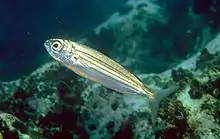| Boops | |
|---|---|
 | |
| Boops boops | |
| Scientific classification | |
| Domain: | Eukaryota |
| Kingdom: | Animalia |
| Phylum: | Chordata |
| Class: | Actinopterygii |
| Order: | Spariformes |
| Family: | Sparidae |
| Genus: | Boops Cuvier, 1814 |
| Type species | |
| Sparus boops Linnaeus, 1758 | |
| Species | |
|
see text | |
| Synonyms[1][2] | |
| |
Boops is a genus of marine ray-finned fishes belonging to the family Sparidae, the seabreams and porgies. There are two species in this genus, one in the Western Atlantic and Mediterranean, and the other in the Western Indian Ocean.
Taxonomy
Boops was first proposed as a genus in 1814 by the French zoologist Georges Cuvier with Sparus boops being its type species by "absolute tautonymy".[3] This taxon is placed in the family Sparidae within the order Spariformes by the 5th edition of Fishes of the World.[4] Some authorities classify this genus in the subfamily Boopsinae,[1] but the 5th edition of Fishes of the World does not recognise subfamilies within the Sparidae.[4]
Etymology
Boops derives from the Ancient Greek βό (bo) meaning 'ox' and ὤψ (ops) meaning 'eye', referring to its large eyes.[5]
Species
Boops contains 2 species:[6]
- Boops boops (Linnaeus, 1758) (Bogue)
- Boops lineata (Boulenger, 1892) (Striped boga)
Characteristics
Boops is characterised by having a torpedo-shaped, elongated body with large eyes, the diameter of the eyes being longer than the snout. The pectoral fins are short, being three-quarters the length of the head and the caudal fin has a deep fork. There is a single row of teeth in the jaws, these are incisor-like. There are dark stripes along the otherwise silvery body.[7] The largest of the 2 species is the bogue, which has a maximum published total length of 40 cm (16 in) while the striped boga has a maximum publsihed total length of 25 cm (9.8 in).[6]
Distribution and habitat
Boops species are parapatric. The bogue is found in the eastern Atlantic Ocean from Norway south to Angola and in the Mediterranean and Black Seas.[8] The silvery boga is found in the western Indian Ocean along the southern coast of the Arabian Peninsula from central Yemen to the Gulf of Oman.[9] They are gregarious fishes that form schools in shallow coastal waters.[8]
Fisheries
Boops are fished for, although the smaller silvery boga is probably only taken by subsistence fishers. The bogue is pursued commercially and used as a food fish, bait in tuna fisheries and to make fish meal.[10]
References
- 1 2 Parenti, Paolo (2019). "An annotated checklist of the fishes of the family Sparidae". FishTaxa. 4 (2).
- ↑ Fowler, Henry W. (1936). "The Marine Fishes of West Africa Based on the Collection of the American Museum Congo Expedition, 1909–1915. Part II". Bulletin of the American Museum of Natural History. 70: 848–850. hdl:2246/1072.
- ↑ Eschmeyer, William N.; Fricke, Ron & van der Laan, Richard (eds.). "Genera in the family Sparidae". Catalog of Fishes. California Academy of Sciences. Retrieved 31 December 2023.
- 1 2 Nelson, J.S.; Grande, T.C.; Wilson, M.V.H. (2016). Fishes of the World (5th ed.). Hoboken, NJ: John Wiley & Sons. pp. 502–506. doi:10.1002/9781119174844. ISBN 978-1-118-34233-6. LCCN 2015037522. OCLC 951899884. OL 25909650M.
- ↑ "Order SPARIFORMES: Families LETHRINIDAE, NEMIPTERIDAE and SPARIDAE". The ETYFish Project Fish Name Etymology Database. Christopher Scharpf. 22 December 2022. Retrieved 28 December 2023.
- 1 2 Froese, Rainer and Pauly, Daniel, eds. (2023). Species of Boops in FishBase. October 2023 version.
- ↑ Yukio Iwatsuki and Phillip C Heemstra (2022). "Family Sparidae". In Phillip C Heemstra; Elaine Heemstra; David A Ebert; Wouter Holleman; and John E Randall (eds.). Coastal Fishes of the Western Indian Ocean (PDF). Vol. 3. South African Institute for Aquatic Biodiversity. pp. 284–315. ISBN 978-1-990951-32-9.
- 1 2 Froese, Rainer; Pauly, Daniel (eds.) (2023). "Boops boops" in FishBase. October 2023 version.
- ↑ Iwatsuki, Y.; Russell, B.; Pollard, D.; et al. (2014). "Boops lineatus". IUCN Red List of Threatened Species. 2014: e.T170171A1287031. doi:10.2305/IUCN.UK.2014-3.RLTS.T170171A1287031.en. Retrieved 31 December 2023.
- ↑ Pollard, D.; Carpenter, K.E. & Russell, B. (2014). "Boops boops". IUCN Red List of Threatened Species. 2014: e.T170251A1301787. doi:10.2305/IUCN.UK.2014-3.RLTS.T170251A1301787.en. Retrieved 31 December 2023.